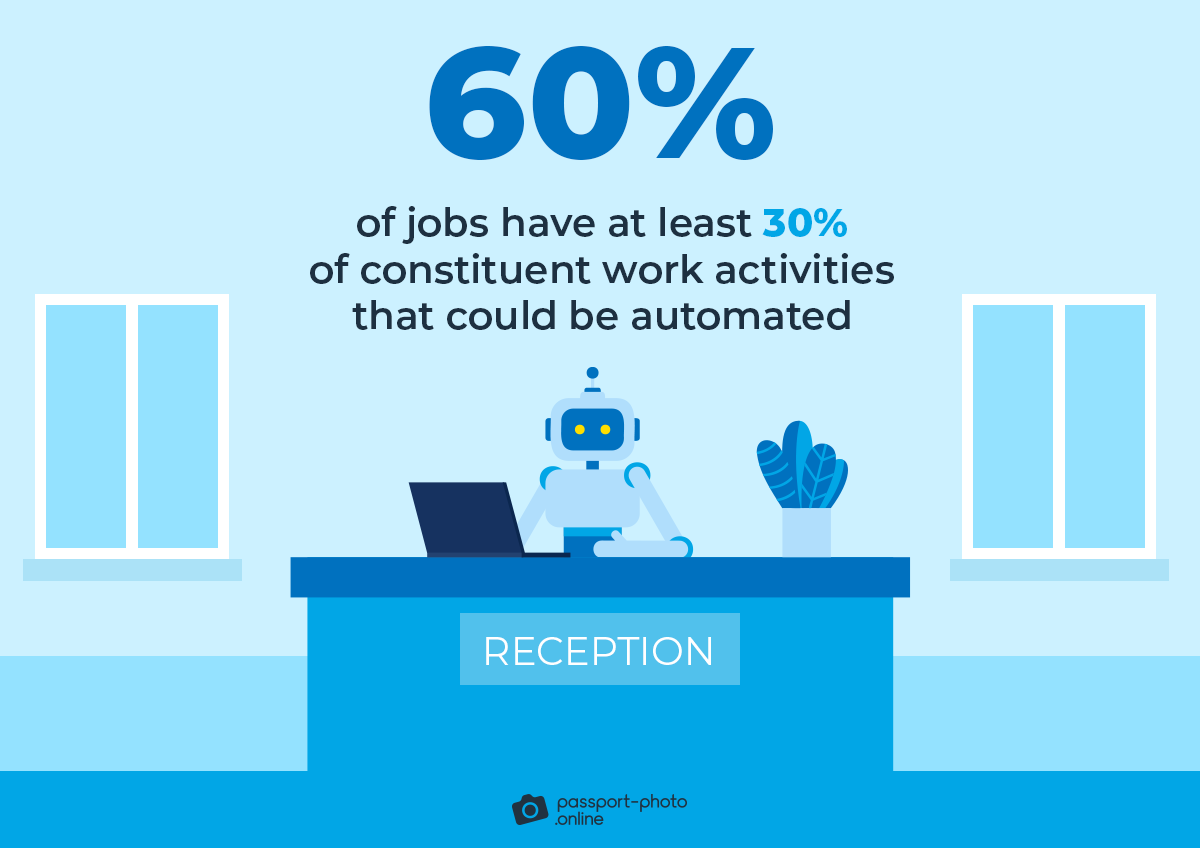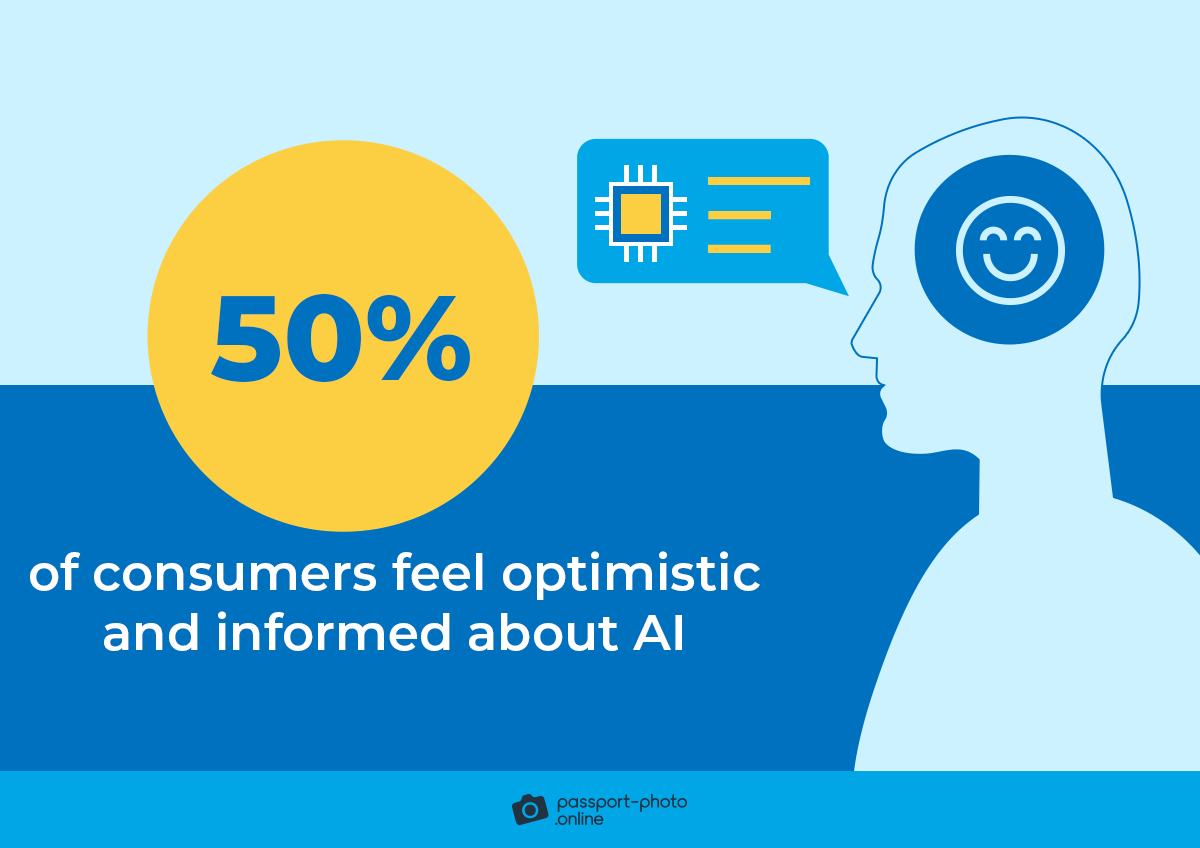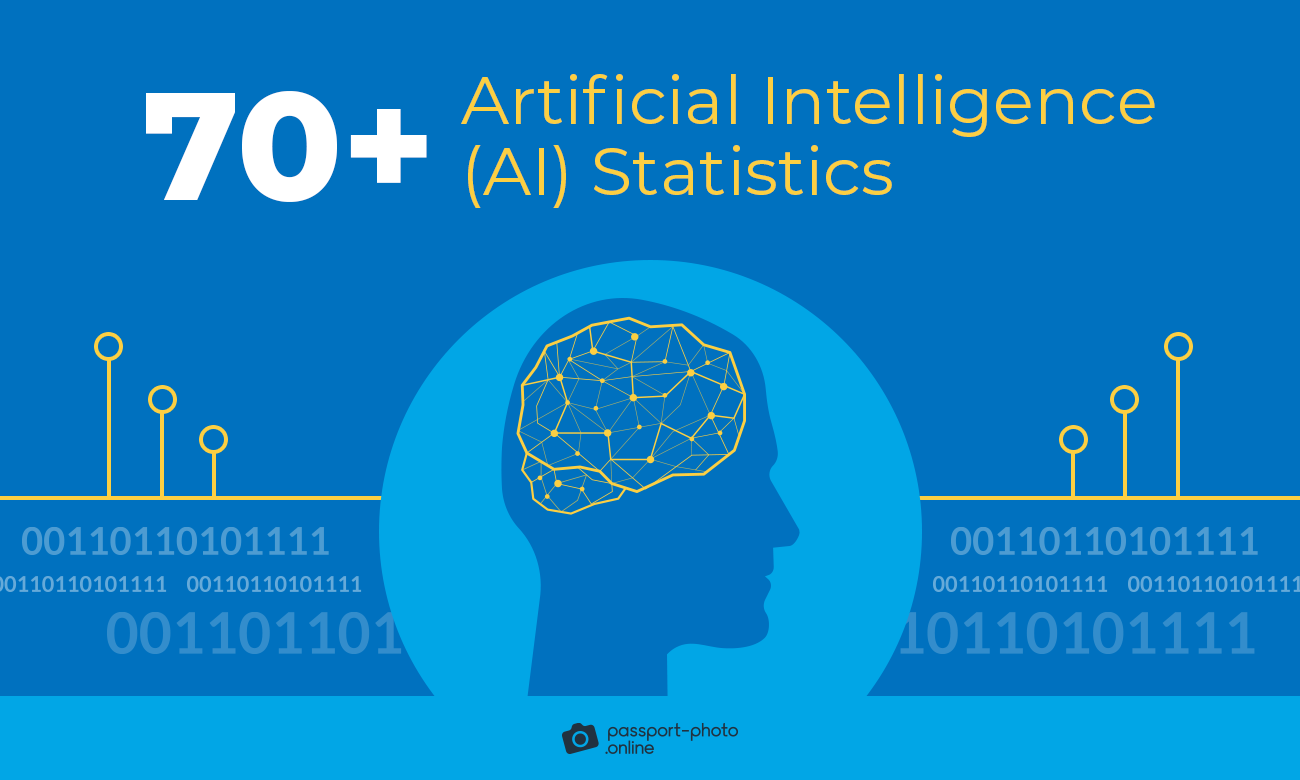AI is taking the world by storm.
Don’t believe it?
Think of self-driving cars (Tesla), navigation (Google Maps), or even virtual assistants (Siri): all of them rely heavily on AI. You might have also heard about ChatGPT, which lets you have human-like conversations with a chatbot system that’s now making a lot of noise online.
So—
At Passport Photo Online, we’ve decided to create a data-driven roundup and give you a comprehensive look at today’s state of AI.
Top 10 AI Statistics You Should Know in 2025

- The global AI market was valued at $327B+ in 2021. It’s projected to reach 1.3T by 2029.
- 45% of organizations believe AI will improve remote work.
- 44% of companies that implemented AI report a reduction in business costs.
- Almost nine out of 10 organizations (87%) believe AI will give them an edge.
- Over half of executives (54%) say AI increased productivity in their businesses.
- 38% of US jobs might be at high risk of automation by the early 2030s.
- Between 75 and 375M employees will have to reskill and change careers by 2030.
- Seven in 10 consumers believe AI can make their lives better.
- 88% of consumers want businesses to be transparent about using AI-powered bots.
- Executives expect AI to deliver more efficient business processes (74%), create new business models (55%), and enable the creation of new products and services (54%).
Fun Facts about Artificial Intelligence
- 44% of people would get in a self-driving Uber car if it came to pick them up.
- IBM’s AI can predict which employees will quit with 95% accuracy.
- Most people (~60%) think they can spot an AI-powered chat from a mile away.

- Persado’s AI system made ads for JP Morgan that generated 2–5 times more unique clicks than those created by human copywriters.
- Seven in 10 consumers harbor some fear of AI—a quarter worry the machines will take over the world.

- 82% of working professionals believe robots can support their careers better than humans.
- In 2020, 4.2B digital voice assistants were used worldwide.
AI Market
- In 2021, the total AI startup funding hit $20B, a record high for the market.
- ByteDance was the largest AI startup in 2021, with a valuation of $140B+. Its algorithms deliver customized content feeds to TikTok users, among others.
- IBM leads the current AI market race, holding over 9% of the global market share.

- IBM was the largest owner of active machine learning (ML) and AI patent families worldwide, with 5,538 families owned as of November 2020.
- Cybersecurity (52%) and customer care (48%) are AI’s most valued use cases.
AI vs. Business: Stats & Facts
- AI can improve labor productivity by 40%.

- 78% of IT and engineering leaders use or plan to use AI as part of their workflow automation initiatives.
- 60% of employees say their organization uses AI—another 52% plan to use it in the future.
- Seven in 10 companies today use ML.

- 86% of workers say AI became a mainstream technology.
- The top-ranked AI applications are 1) managing risk, fraud, and cybersecurity threats, 2) improving AI ethics, explainability, and bias detection, and 3) helping employees make better decisions.
- Two-thirds of employees say their companies’ AI investments will continue to increase over the next three years.
- 43% of executives believe AI tech will transform their organization in the next 1–3 years.
- 52% of companies accelerated their AI adoption plans due to COVID-19.

| The Companies That Have Fully Embraced AI Say It Helped | Share |
|---|---|
| Create better customer experiences | 86% |
| Improve decision making | 75% |
| Innovate products or services | 75% |
| Achieve cost savings | 70% |
| Increase productivity | 64% |
- 84% of C-suite executives believe they must leverage AI to achieve growth objectives—yet 76% struggle with scaling AI in their organizations.
- Three in four C-suite executives believe they might go out of business if they don’t scale AI in the next five years.

- Companies that scale AI have ~2x the success rate and 3x the return from AI investments vs. companies pursuing siloed proof of concept.
The Impact of Artificial Intelligence on Employment
- AI is expected to replace ~85M jobs globally by 2025.

- 49% of people feel AI has already made some people lose their jobs.
- The top five jobs at the highest risk of automation are food science technicians, procurement clerks, library technicians, cargo and freight agents, and tax preparers.
- The robot revolution will likely create ~97M new jobs.

- Between 8 and 9% of 2030 labor demand will be in brand-new occupations.
- Over half of business and HR leaders (54%) expect AI to impact the nature of jobs in their organizations in the next three years.
- Few occupations (less than 5%) come with activities that can be fully automated.
- Yet, 60% of jobs have at least 30% of constituent work activities that could be automated.

- Up to 30% of the hours worked globally could be automated by 2030.
- Analytical thinking, creativity, and flexibility are among the top skills employers will look for in the upcoming years.

Looking for passport photos? Discover more information:
What Consumers Think About AI
- Seven in 10 Americans say they know what AI is.
- Half of consumers (50%) feel optimistic and informed about AI.

- 40% know AI is present in Amazon Alexa or Google Home.
- 33% of consumers know they already use AI platforms.
- When they think of AI, 53% think mainly of robots, and 40% think of self-driving cars.
- Over half of people (58%) get information on AI from movies, TV, or social media.
- A little over a quarter of consumers (26%) think they interact with AI at least once a day.
- Consumers feel most comfortable and trusting of AI when it’s used for commerce (33%) and entertainment (26%).
- 38% of people don’t believe AI delivers the same or better customer service as humans.

- 43% feel AI will lower customer service satisfaction and increase complaints.
- 35% of consumers are comfortable with businesses using AI to interact with them.
- 80% of people still want to chat online with humans vs. machines.

- While 70% of consumers want AI to improve their lives, only 27% are willing to give their personal data to get better service.
- 48% of consumers doubt their private information (e.g., credit card data) will remain secure if AI helps protect their privacy.
- On the other hand, 41% believe that with AI, businesses will grow more careful about protecting customers’ data.
The Future of AI: Trends
- The global AI market is expected to reach half a trillion dollars by 2024.

- The Wearable AI market size will likely hit $180B by 2025.
- The global autonomous vehicle market size is likely to garner $556.67B by 2026.

- The number of digital voice assistants will reach 8.4B by 2024.
- The US will likely get a 14.5% boost to GDP in 2030, giving way to China (26% boost).
- AI could contribute up to $15.7T to the global economy in 2030. Of this, $6.6T will come from increased productivity alone.
- Global AI in the fashion market is expected to hit $4.4B by 2027.
- 72% of business leaders feel optimistic about AI’s role in the future.
- Most people believe AI will help solve problems that plague modern society (63%) and help people lead more fulfilling lives (59%).
- AI will power 95% of all customer interactions by 2025—including phone and online conversations—with customers unable to “spot the bot.”

FAQ
How big is the AI market?
Does AI improve productivity at work?
How many jobs are at risk of automation?
Will AI put people out of jobs?
Are humans afraid of AI?
What's the biggest AI company?
How many AI assistants are there?
Stacking It All Up
There you have it.
A comprehensive list of AI trends, facts, and stats for 2025 you can use to understand AI’s current state and where it’s headed.
Let us know in the comments if there are any other artificial intelligence figures you’d like to see.
Fair Use Statement
Did you like our infographics? If so, feel free to share them with your audience. Just remember to mention the source and link back to this page.
Sources
- Abramovich G., “PwC: Artificial Intelligence Will Be the Business Advantage of the Future”
- Accenture, “AI: Built to Scale”
- APQC, “2021 Supply Chain Challenges and Priorities: Survey Report”
- Blumberg Capital, “Artificial Intelligence in 2019: Getting past the Adoption Tipping Point”
- Buchholz K., “These Are the Countries Where AI Is Aiding Productivity the Most”
- Cognizant, “Jobs of the Future Index”
- DriversEd, “2019 State of Self-Driving Cars Report”
- Gartner, “Gartner Survey Shows 37% of Organizations Have Implemented AI in Some Form”
- Global Market Insights, “Global Wearable AI Market Size to Reach $180bn by 2025”
- Jadhav A., “2021 Autonomous Vehicle Market”
- Mackay H., “Artificial Intelligence Will Be Big, So Prepare”
- McKinsey, “Global AI Survey: AI Proves Its Worth, but Few Scale Impact”
- McKinsey, “Jobs Lost, Jobs Gained: What the Future of Work Will Mean for Jobs, Skills, and Wages”
- McKinsey, “The State of AI in 2021”
- Microsoft, “Powering the Future of the Customer Experience”
- Oracle, “AI@Work 2021 Global Research Report”
- Pasquarelli A., “Chase Commits to AI after Machines Outperform Humans in Copywriting Trials”
- Pega, “What Consumers Really Think About AI: A Global Study”
- PwC, “AI Predictions 2021”
- PwC, “Global Artificial Intelligence Study: Exploiting the AI Revolution”
- PwC, “How Can Organisations Reshape Business Strategy with AI?”
- PwC, “UK Economic Outlook March”
- Rosenbaum E., “IBM Artificial Intelligence Can Predict with 95% Accuracy Which Workers Are about to Quit Their Jobs”
- Russo A., “Recession and Automation Changes Our Future of Work, but There Are Jobs Coming, Report Says”
- SalesForce, “New Report Shows Huge Rise in AI, Automation as Customer, Employee Expectations Shift”
- Schneider M., “New Survey Reports US Entrepreneurs Optimistic about Growth and Technology”
- Statista, “Artificial Intelligence (AI) worldwide – Statistics & Facts”
- Statista, “Business Organizations’ Reasons for Adopting Artificial Intelligence (AI) Worldwide from 2017 to 2020”
- Statista, “Number of Digital Voice Assistants in Use Worldwide from 2019 to 2024”
- The AI Journal, “AI in a Post-COVID-19 World”
- Will Robots Take My Job, “Jobs at High Risk of Automation”
- World Economic Forum, “The Future of Jobs Report 2020”

As a Digital PR specialist and a member of the Society of Professional Journalists (SPJ), Max has 5+ years of writing experience.
Over the course of his career, Max’s work has garnered significant attention, with features in numerous prominent publications such as The New York Times, Forbes, Inc., Business Insider, Fast Company, Entrepreneur, BBC, TechRepublic, Glassdoor, and G2.









